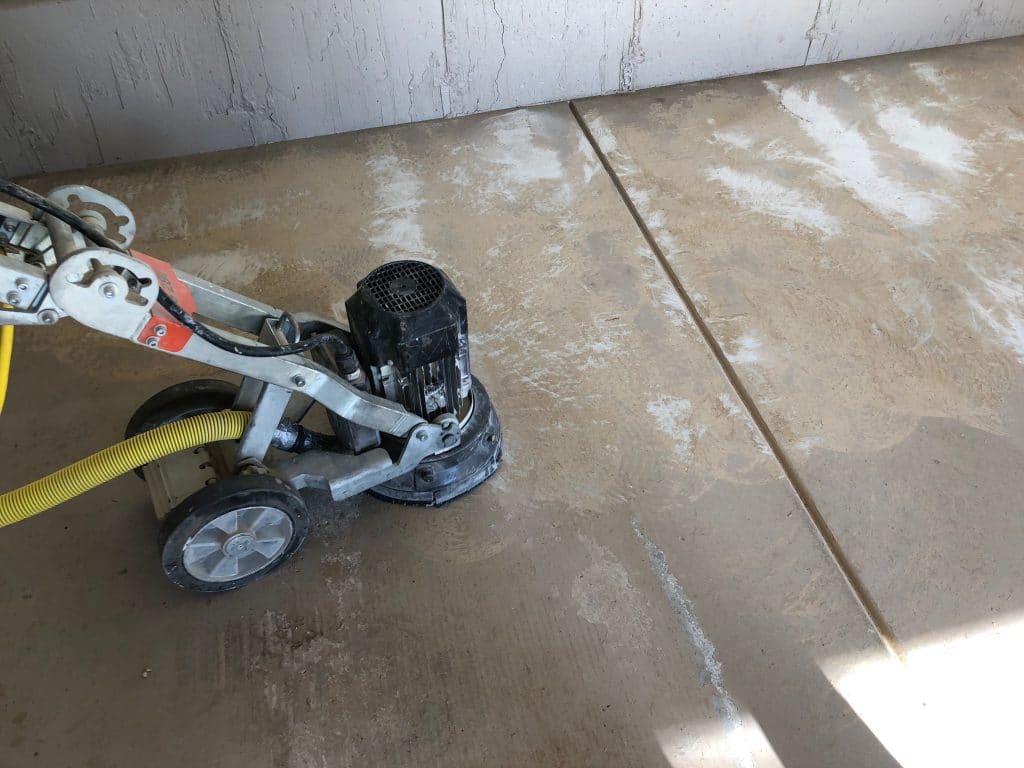Grinding Versus Etching
Most everyone knows epoxy flooring has the ability to completely transform the entire look of a garage, porch, or basement. It not only has a better appearance than concrete, but it’s sturdier and lasts longer, too.
If you choose to install your own epoxy floor, there is one essential step you must take the time to execute correctly—and you certainly cannot skip it altogether—if you want to have a successful project. (See 7 Reasons the epoxy on your garage floor is peeling.)
Known as profiling, it’s the most important part of the epoxy flooring installation process, but it’s also the most often overlooked.
Profiling is how the concrete is prepped to ensure that the epoxy coating completely binds to the surface. However, there is a lot of confusion and misunderstanding out there about profiling. For example, many are under the false impression that if a concrete floor is brand new it doesn’t need to be profiled, but this couldn’t be further from the truth! After the concrete has been poured, it is buffed and treated to make its surface smooth, which is the exact opposite of the texture required for installing epoxy.
Profiling is essentially a process of roughing up the concrete surface pores in order to make it as permeable and absorbent as possible. This ensures that the epoxy coating doesn’t lose adhesion over time.
Grinding the concrete before installing an epoxy floor.
Click the button below to choose
your date and time!
How to Profile
There are two common methods of profiling a concrete floor. The first way, which is cheaper, is performed by using acid to “etch” the concrete surface.
But like most cheap things, you get what you pay for!
It’s nearly impossible to profile concrete evenly with acid etching, and before applying it, you’ll have to thoroughly clean the floor as the acid will not remove dirt and/or oil from the surface. Furthermore, if your concrete has been treated with any kind of sealant or finishing coat, acid etching won’t work at all. Lastly, your floor will need to be 100% completely dry before installing the epoxy coating… or it will fail!
The second way to prepare concrete for epoxy is by grinding the surface mechanically.
The industry’s most qualified experts recommend mechanical grinding over all other methods of profiling.
Using a grinder (this and this are what we use) with the Redi lock system for diamond tooling. Unlike acid etching, mechanical grinding also removes excess dirt and oil from the floor’s surface, a crucial step because if any is left behind it will be extremely difficult to get the epoxy coating to adhere. Pro tip – use a HEPA vacuum to capture the ground concrete and keep your area clean!
So why even attempt to profile any other way?
The primary reason why homeowners (and most painters) try to profile their floors without mechanical grinding is that it is not a procedure they can do themselves. The few who do rent a grinder and attempt to prep their floor themselves usually end up damaging, even destroying their concrete entirely.
Painters etch, professionals grind… period.

Grinding a profile into concrete.
Before You Choose an Installer
So you have decided to hire a pro… great! Don’t forget to ask your local pro some important questions before you hand over your Visa card.
First, ask the installer if they do acid etching, shot blast, or grinding the concrete surface mechanically. If they etch, ask them to explain why. Equally important, find out how they dispose of the acid after it’s used. i ge will not blister and peel, and if so, for how long? If they grind, how do they determine how much to grind? What happens if they damage your concrete floor? Will they fix divots and cracks before they begin? With what product and why?
Or, you could simply hire the experts here at Michiana Epoxy. We own our grinders, and our technicians have years of experience using them. We know how to fix bad floors, make old floors look new, and add value to your home… all while having a floor you can enjoy… for life!
